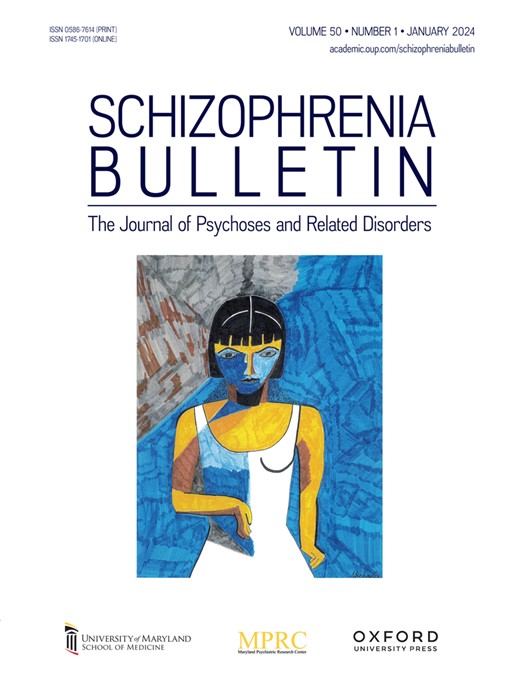The Relationship Among Range Adaptation, Social Anhedonia, and Social Functioning: A Combined Magnetic Resonance Spectroscopy and Resting-State fMRI Study
IF 5.3
1区 医学
Q1 PSYCHIATRY
引用次数: 0
Abstract
Background and Hypothesis Social anhedonia is a core feature of schizotypy and correlates significantly with social functioning and range adaptation. Range adaptation refers to representing a stimulus value based on its relative position in the range of pre-experienced values. This study aimed to examine the resting-state neural correlates of range adaptation and its associations with social anhedonia and social functioning. Study Design In study 1, 60 participants completed resting-state magnetic resonance spectroscopy and fMRI scans. Range adaptation was assessed by a valid effort-based decision-making paradigm. Self-reported questionnaires was used to measure social anhedonia and social functioning. Study 2 utilized 26 pairs of participants with high (HSoA) and low levels of social anhedonia (LSoA) to examine the group difference in range adaptation’s neural correlates and its relationship with social anhedonia and social functioning. An independent sample of 40 pairs of HSoA and LSoA was used to verify the findings. Study Results Study 1 showed that range adaptation correlated with excitation–inhibition balance (EIB) and ventral prefrontal cortex (vPFC) functional connectivity, which in turn correlating positively with social functioning. Range adaptation was specifically determined by the EIB via mediation of ventral-medial prefrontal cortex functional connectivities. Study 2 found HSoA and LSoA participants exhibiting comparable EIB and vPFC connectivities. However, EIB and vPFC connectivities were negatively correlated with social anhedonia and social functioning in HSoA participants. Conclusions EIB and vPFC functional connectivity is putative neural correlates for range adaptation. Such neural correlates are associated with social anhedonia and social functioning.求助全文
约1分钟内获得全文
求助全文
来源期刊

Schizophrenia Bulletin
医学-精神病学
CiteScore
11.40
自引率
6.10%
发文量
163
审稿时长
4-8 weeks
期刊介绍:
Schizophrenia Bulletin seeks to review recent developments and empirically based hypotheses regarding the etiology and treatment of schizophrenia. We view the field as broad and deep, and will publish new knowledge ranging from the molecular basis to social and cultural factors. We will give new emphasis to translational reports which simultaneously highlight basic neurobiological mechanisms and clinical manifestations. Some of the Bulletin content is invited as special features or manuscripts organized as a theme by special guest editors. Most pages of the Bulletin are devoted to unsolicited manuscripts of high quality that report original data or where we can provide a special venue for a major study or workshop report. Supplement issues are sometimes provided for manuscripts reporting from a recent conference.
 求助内容:
求助内容: 应助结果提醒方式:
应助结果提醒方式:


